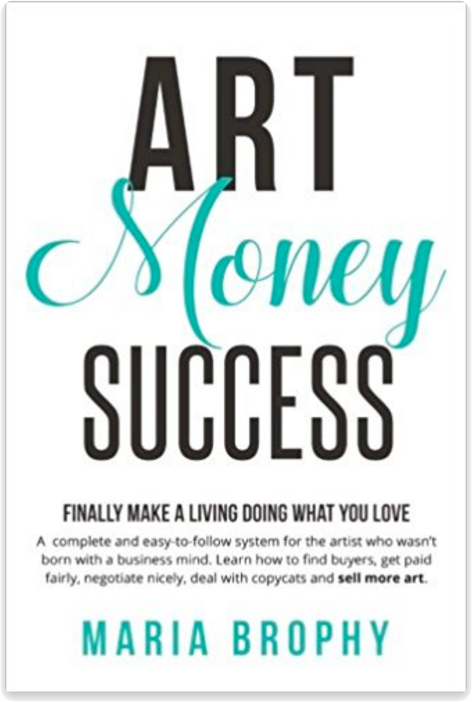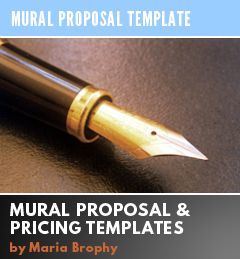 Just how much are your opportunities really costing you? Do you take the time to determine your expenses vs. your profit?
Just how much are your opportunities really costing you? Do you take the time to determine your expenses vs. your profit?
Before you commit to an event or exhibit, you need to look at the numbers and know exactly how much money you are going to spend, how much you are going to make, and what expenses are involved with that commitment. Otherwise, you may find yourself putting out more than you take in.
A successful business, whether you’re an artist or a florist or a woodworker, is where you are bringing in more money than you are sending out. Profit = Income – Expenses. Forgive me if I’m telling you something simple that you already know, but trust me, some creative professionals need to be reminded of this.
The artists who look at the actual numbers before they enter into an agreement are the ones who will, in the end, find financial success. Why oh why don’t they teach this in art school?!
Sometimes we get so caught up in the excitement of an opportunity that we don’t stop to think about what it’s costing us.
Take, for example, the happiness you feel when you are invited to exhibit at a gallery. You are flattered that someone would appreciate your art enough to display it on their walls. And in some way, you see it as validation of your talent.
You go out and buy all of the materials you need, the canvas, the frames, the paint. You plan out a series of paintings and put in the hours and months. You deliver the masterpieces and the space in which your art is hanging looks fabulous. You did a great job. The gallery is pleased. Your art made them look good. (And they didn’t have to pay you dime.) Now it’s out of your hands. So is something else – money. Unlike all other businesses, you don’t get your money back unless or until something sells.
Then, as time goes on, you aren’t making it. You’re forced to keep that “other job” that you can’t wait to quit so you can be a full-time artist. Your bank account is shrinking, but you’re not sure why. “I guess this starving artist thing is true” you think to yourself, disappointed.
It could be that you are giving too much for too little in return. In business we would call that a losing proposition.
Imagine going into the Bank of America asking for a business loan. You explain that your business plan is to produce wonderful artwork, spend a lot of money on supplies, deliver it to the retailer (gallery) and then wait and see what sells. If it doesn’t sell, you have to pay to ship the goods back and start all over again.
If you tried to get a business loan with that plan, they’d laugh you all the way out of the bank!
But for some reason, many in the art world think this is acceptable. Due to the fact that “it’s always been done this way,” we don’t blink an eye at the thought of putting expensive artworks into a gallery, paying the shipping fees, and then only getting 50% back (which, after the artists’ expenses, it’s actually about 30%).
The gallery honeymoon is over as soon as we realize that this old system can be a financial drain. But, thanks to the internet, times have changed and artists can sell artwork directly to collectors, thus giving themselves better pay and control over their careers.
That being said, it would be blind of me not to acknowledge that there are many different ways to run your art business, and not one size fits all.
For a small percentage of artists, the gallery system works. And when I say “works”, I mean that it supports them financially. This percentage is so small that I rarely meet artists who do make a profit solely from the gallery system. Good for them – I cheer them on!
But, most everyone else is supplementing their gallery income through a second job or a spouse or other forms of art sales.
And though I write about this often, I can’t say it enough. Artist’s have to be responsible for their own financial situation. And the best way to take control is to look at your numbers.
FALL IN LOVE WITH THE NUMBERS, EVEN IF YOU HATE THEM
I’ve worked with a business coach, Ralph White, off and on for a few years. He taught me to enjoy numbers. “But I don’t like numbers, Ralph,” I’d complain. He would encourage me, and thanks to his nagging, I’ve gotten over it and run our business to make a profit. It’s what’s helped us survive the recent downturn in the economy.
Ralph told me “Don’t run your business like it’s going to pick up later. Run your business to make a profit, right now.” Makes sense, doesn’t it? Sometimes we need to be reminded…
Every single thing we do has to net a profit, or it may not be worth doing.
This year I turned down several promotional events because it was going to lose us money. And the companies that really wanted us there? They paid our entire way – airfare, hotel, meals. Suddenly, our bottom line is looking really good.
You don’t like numbers? Neither did I. But as soon as I realized how much money we were losing making others look good, I changed my ways. And I implore you to, as well.
It will make the difference between being able to do what you love for living, or having to do that which you don’t love just to survive.
ARE YOU PLAYING THE ROLE OF AN ART BANKER?
Drew and I made the decision to get out of the art banking business a few years ago. It’s done wonders for our ability to focus on making more money for less work. Let me explain:
ART BANKER is my affectionate term for the person who spends their own money on supplies and time creating artwork that they then “loan” on consignment. They don’t have a guarantee that this “loan” will ever be paid back, but if it does, it’s usually 6-12 months, interest free for the gallery.
If you ever wonder why some artists just can’t support themselves, this could be one of the reasons. This is a bad, bad business plan that for most people will fail.
THE ECONOMY HAS CHANGED MY BAD WAYS AND FORCED ME TO SCRUTINIZE THE NUMBERS
In 2009 our gross income of selling Drew’s art was down almost 50% from 2008. The economy really pinched us. But if there’s one good thing that came out of last year’s squeeze, it was that we were forced to scrutinize the numbers with everything we do.
When I pulled out the magnifying glass and began to see clearly just how much some of the “great opportunities” were really costing us, I was surprised at how much we spent to make other companies look good.
Recently Drew was asked to have a solo art exhibit in a gallery in Hawaii. They offered to cover shipping of the artwork and pay 60% once the artwork sells.
Often we get offers like this. And rarely do we say yes because of the cost involved. First, I want to say that we fully appreciate that an upscale gallery wants to represent Drew. It’s flattering and it evokes this great vision of us being able to go to Hawaii on business and sell artwork. Who wouldn’t want to do that? But the numbers didn’t add up.
KNOW THE NUMBERS AND WHAT IT’S COSTING YOU
I ran it through our policy called The Profit Policy. (Please copy and use this for yourself.)
In order for us to say “YES” to any new project, event or venture, it has to meet all four of the following criteria of The Profit Policy:
- There is a profit in it
- It does not require us to be an Art Banker (we don’t have to front money for expenses and supplies)
- Our travel and material expenses are paid for
- It will be enjoyable to us
There are exceptions to every rule, and here’s an exception to the above: If there’s no profit but it’s an excellent marketing opportunity, it it exposes Drew’s art to a large number of people, guaranteed, AND if they cover travel expenses, we’ll do it.
WEIGH THE PROS AND CONS AND KNOW YOUR COSTS
Sometimes it’s worth it to spend money to get an opportunity. If you’re an emerging artist, it may be required for you to put yourself out there and exhibit in galleries and play that game for awhile. But please, don’t stake your career on it. And once you’ve been in the game for a few years, stop giving more than you’re paid. You can’t sustain yourself that way. Not only will you go broke, you’ll burn yourself out.
HOW MUCH IS IT REALLY COSTING YOU? FIGURE IT OUT
Take the time to figure out how much an exhibit or event will cost you. Make a spreadsheet and figure in everything, including gas and materials and travel meals. Get in the habit of knowing exactly how much money you’re making in each gallery you exhibit in. Become familiar with numbers and always know how much profit you’ve made.
Sometimes looking at the numbers can be downright disappointing and scary.
But there’s power in knowledge. A wise (and rich) friend once told me “numbers don’t lie.”
The numbers will provide you with the knowledge you need to make the right decisions.
IF YOU FIND THAT YOU ARE LOSING MONEY WITH A GALLERY OR PARTNERSHIP
If, after looking at your numbers, you find that you are losing money with certain galleries or partnerships, there are a couple things you could do:
1 – Ask to renegotiate your arrangement. Show them the numbers and tell them that this isn’t a good business move for you. Ask that they increase your percentage so that it makes sense for you to continue. Most people will not want to see you lose money and they will work with you on this.
2 – Leave the situation that’s losing you money. This way you are freed up to focus on new relationships that will earn you a profit.
CRUNCHING THE NUMBERS WOKE ME UP
So, back to the Hawaii opportunity. We wanted to make this work, because the owner of the gallery is one of our best clients through another business and we know that anything that he does is top notch.
But nothing ruins the fantasy of being in Hawaii like the reality of the expenses. This is a great example of how seeing the numbers is a like a cold slap in the face!
Below is a list of the expenses we estimated for Drew to paint in Kauai for 3 weeks prior to his solo show. (It’s safer, easier and cheaper to send Drew there to paint on-site, rather than paint here and ship a crate, since his pieces are large and a few are fragile surfboards. It’s very expensive and risky to ship that stuff.)
| Airfare | $600 |
| Rental Car | $1,500 |
| Art Supplies and framing | $2,500 |
| Food & Misc ($75/day x 21) | $1,575 |
| Luggage/Check in/Taxes | $ 300 |
| Accommodations 21 days ($75) | $1,575 |
| TOTAL Expenses | $8,050 |
If our total expenses are $8,050, than we have to gross $25,000 (we keep 60%) on opening night just to cover our expenses and pay Drew for his three weeks of work.
It’s possible to gross $25,000 on opening, but it’s not guaranteed. And in this economy, there are safer risks we could take. Such as, paint the paintings here and sell them ourselves and take a real three week vacation instead! (See how my mind works?)
I was so frustrated when I realized that it would be financially corrupt for us to do a show in Hawaii. How do other mainland artists do it, I wondered?
To find my answer, I called a friend who has great success selling his artwork Hawaii. I thought for sure he would tell me that the galleries cover his costs. He flies to Hawaii every summer to paint on site, and he spends a month at time there. I was dismayed when he told me that he covers all his expenses. But he has a friend that he can stay with for free. The galleries he works with keeps 50% of the sales – this also disappointed me. He explained that in his case, he sells many pieces for $6,000 or more and in the past 3 years he’s sold over 50 paintings in Hawaii. He assured me that he is making a profit and that it’s been a great deal for him.
I suppose if you’re going to exhibit in just one gallery that far away, it doesn’t make financial sense. You’ll lose money on the shipping, materials and travel expenses. But if you plan to focus your efforts on growing your presence in many galleries in that area, it can pay off.
For us, we decided that instead of playing “Art Banker”, we would offer the Hawaii gallery Drew’s original paintings at a greatly discounted wholesale price. I sent a letter to the gallerist and explained why we weren’t able to place artwork on consignment (it’s not a fit with our business model of making a profit), but that we will give deep discounts if they purchase the paintings and pay at time of delivery.
Gladly, he was open to that and showed interest in Drew’s smaller, less expensive pieces. He understood the economics of fronting money for no guaranteed return – he’s a businessman after all.
And that’s when I came to another realization – there’s no “one way fits all.” I think gallery owners are starting to realize that, just like other retail stores, they have to pay for their inventory sometimes. And this is a change that all artists can live with.
The next time you are invited to do a show, or a promotional event, ask yourself the four Profit Policy questions. And if you find that you won’t make a profit or even break even, do something most artists are afraid to do: Ask the host to help cover the travel expenses and/or supply costs. You might be surprised when they say yes.
Maria xxoo
(Art Credit: Pierre Bouret)
.














